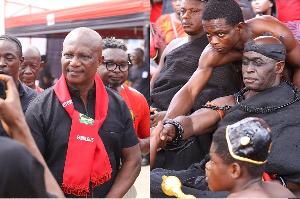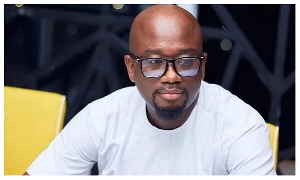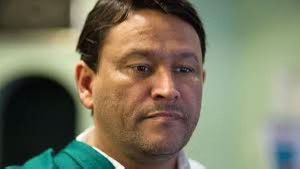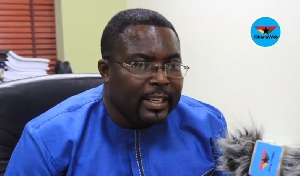By Manasseh Azure Awuni/The Finder
Kojo Njorfuni doesn’t look like someone who will survive another day. His breath seems to be failing, and as he struggles to breathe, you can count all his ribs without getting close to him. But the thirteen-year-old boy, who is paralysed from his waist downwards, has defied death and endured suffering with peerless stoicism. He even has hopes of getting back to school one day.
Kojo’s ankles and knees are draped in white bandages, which are soaked with fluid discharges from his sores. As his father turns him over the bed to give a clear view of what he calls the “decay” of his lower back and buttocks, Kojo writhes as the rags which cushion him are all soaked with the discharge and hold on to the bandage. A urinary catheter is also inserted into him to drain urine from his bladder since he cannot visit the washroom.
Kojo has been in the hospital for four months now and though the medical authorities speak of some improvement in his condition, his sores are far from being healed. The health authorities here say they don’t have the capacity to work on the cause of his paralyses – a fractured spine. So unlike other patients who see improvements in their conditions, Kojo and his family only hang on to faint hope, an expectation of some miracle.
“Sometimes, I wish my son never stepped into the classroom. I would have preferred a son who could neither read nor write to the suffering Kojo is going through now,” Mr. Njorfuni Wajah, Kojo’s father, says, fixing a vacant and distant stare as if he’s trying to see beyond the wall of the hospital ward, back to the day it all started. It was a day he dreads to remember, but which he cannot forget.
The Banda Tragedy
Njorfuni Wajah did not go to farm on Friday, November 21, 2008. Quite apart from the fact that the dry season had set in and there was not much work to do, Friday is Njorfuni’s “bad day.” For many people with similar traditional beliefs, such days are sacred; they neither fish nor farm. On that uneventful morning, Njorfuni Wajah decided to meet a friend at the market square of Banda, a town in the Krachi West District of the Volta Region. His son, Kojo, had eaten his breakfast of rice bought from a nearby vendor and left for school.
Sahadatu Ibrahim, a senior high school leaver, was the class three teacher of English Arabic Primary School in Banda in November 2008. There are only two trained teachers in the school – the headteacher and his assistant. The head teacher does not teach so the fate of the children of this school is left in the hands of some pupil teachers and volunteers from the community. The class three teacher had just finished marking the class register and gone to place it in the office when the unexpected happened.
“It took all of us by surprise,” says Yeyie Sei Selisah, the assistant head teacher. “It had not rained in a long time. Neither was there a storm that day. All we saw was that the walls collapsed.”
Why the building collapsed or how it collapsed, however, did not matter. What mattered most were the lives of the pupils, as teachers and older pupils made frantic efforts to rescue the victims. They were swift, but too late to save all of them.
One pupil, Master Godwin Ayensu, who sat near the collapsed wall, died on the spot, while another pupil, Sumaila Labil, fell into coma. Others, including Kojo and Sumaila, had to be rushed to safety. Unfortunately for the children, the road from Banda to Krachi was (and still is) very deplorable and the absence of an ambulance meant that they had to make do with an equally deplorable benz bus. When Njorfuni Wajah heard that his son was among the children injured by the falling classroom wall, he made straight away for the Banda Health Post, where he was told that the children had been transferred to the Krachi Hospital. “Kojo did not look injured. No part of his body was bruised, and since he was not crying, we thought his was not as serious as the rest. For three days, the doctors saw nothing wrong with him, except that he said he could not sit or stand,” Kojo’s father recounts. “It was on the third day when I pressed my hand against his back that I realised his backbone had a problem.”
Health authorities said the extent of injuries sustained by six of the children could not be treated there so they referred Kojo, together with five other pupils, to the Volta Regional Hospital in Ho. But the Krachi Hospital had no ambulance so they had to send for an ambulance from Ho. The ambulance arrived, after four days, the seventh day after the accident. Sumaila was still unconscious.
Injured Children abandoned
Kojo’s father said no official of the Ghana Education Service or the district assembly accompanied parents of the injured children to Ho. And since the parents were not financially prepared, they became stranded when the Volta Regional Hospital again referred them to the Korle-Bu Teaching Hospital in Accra.
Mr. Kwaku Larbi, a presenter on GBC’s Volta Star Radio, said the plight of the children and their parents reached the station through someone and the station decided to appeal for funds to assist them. Kojo’s father said he had met an old friend who hinted him of possible help if the media were brought in. But the situation was so critical that the parents could not wait for external help. Kojo and Sumaila were, however, the only children whose parents were prepared to take them to the Korle-Bu Teaching Hospital. The rest received treatment and left without the recommended surgeries. The reason was they didn’t have money. According to Njorfuni, an official of the GES gave Sumaila’s mother and him GH?50 each, and apart from the ambulance, which was given by the hospital authorities in Ho, nobody offered them any help.
Sumaila regained consciousness after almost two weeks. The health authorities at Korle-Bu said he needed to undergo a surgery but his mother said she could not afford it. When the physical condition improved, he left. But Kojo’s condition had worsened and he had to undergo the surgery.
It was one month and three days after the wall collapsed and fractured his spine that Kojo Njorfuni had his spinal surgery at the Korle-Bu Teaching Hospital. The appeal made on the Volta Star Radio had attracted the sympathy of the Krachi West Constituency Member of Parliament, Hon. Francis Osei-Sarfo, who according to Mr.Kwaku Larbi, donated GH? 1000 to help in the treatment of the children. Mr. Larbi recalls that half of the amount was given for the treatment of Kojo while the rest was shared among the other victims. Kojo’s father has confirmed receiving that amount but stated that it was not enough. He said he sold almost all his valuable assets to survive the sixty-six (66) days he spent in the hospital with his son.
But he was happy that after surgery, Kojo could sit and was doing well. That was, however, not the end of the story. Kojo was asked to return in six months for a medical review, and that was when trouble began.
Pupils still suffering after three years
It is time for ICT in the Primary 3 class and a volunteer teacher has four words inscribed on the board. Around him sit more than fifty pupils, who seem unperturbed by the tides of deprivation. More than half of the class sits on the floor while some share kitchen stools with colleagues. But they should count themselves lucky. At the Nandikrom DA Primary School, where I passed before getting here, the pupils were busily working on their shelter, whose roof was blown away last night. Chairs or no chairs, these pupils look grimly determined to make an impact as they recite after the teacher: Computer! Mouse! Processing! Information! Monitor!
“How many of you have seen a computer before?” I ask after the greetings. No hand goes up. “How many of you have seen a mouse before?” I ask again. This time, half a dozen hands shoot up immediately. And they look utterly disappointed when I tell the first boy that the little troublesome rodent he has seen in his mother’s room is not the mouse being referred to here.
The classroom has no walls separating it from the other classrooms. It was in this classroom that a wall fell and killed a pupil and injured many others three years ago. It was initially built as an open pavilion and later walled with mud bricks to separate one classroom from the others and also to save the children from rain. But after the accident, all the walls were demolished, leaving the structure as open as it was first constructed. It has no traces of any falling wall. But the remnants of that fatal day in November 2008 can be found in the Primary Six classroom, where some of the pupils who were injured now are. Staring blankly into the camera is 14-year-old Sumaila Labil, who was unconscious for two weeks after the accident. He could not undergo the recommended brain surgery. Sumaila is now mentally deformed but he still manages to be in school. “He sometimes threatens to beat up his mother whenever his sickness comes,” says assistant head teacher of the school. Tekoyabe Sanja, a fourteen-year-old girl, is visually impaired as a result of the accident.
Thirteen-year-old Nakoja Nlebekuma is not in school. I trace him home only to find out that his injured ankle, which could not undergo surgery, has still not healed after three years. It is the reason he is not in school. “Sometimes, it is as if someone is using a pin pierce inside my leg,” he says. Tebore Faustina, 16, still feels pains in her left elbow while Sambia Solomon, 15, says his left foot and teeth have not stopped aching since the accident. Emmanuel Lamptey, 12, says he still feels the effect of the accident in his thigh and shoulder while 15-year-old Abdulai Yusif, who says a falling brick hit his head in the process, still suffers from headache.
According to information gathered by this reporter, the GES and the Krachi West District Assembly, which collaborated to transport the children from the school to the hospital, abandoned them afterwards. Checks at the Krachi Government Hospital revealed that the GES and the assembly did not pay the cost of treating the ten pupils who were rushed to the hospital in 2008.
The Krachi West District Director of Education, Mr Benard Akarah, says the GES has no insurance policy to support such pupils. “When it happens, we appeal to individuals and organisations to help, while we report to our superiors, which we did. Beyond that there’s nothing we can do.”
The Boy in the Wheel Chair
After the six months, Kojo Njorfuni could not return to the Korle-Bu Teaching Hospital for the medical review because all attempts by his father to get some money, after defraying part of his previous debts, yielded no results. “I wrote to the district assembly and appealed to the education authorities, but no one gave me any answer,” says Njorfuni Wajah. Kojo has since been paralysed and developed bed sores and other infections that threaten his life. A nurse in Banda, who stumbled upon his condition early this year reported to the district health directorate and they decided to send him to the hospital for treatment. It was during the period that some school children made some donation through the GES to help him. That was spent on drugs and other expenses incurred during his hospitalisation. After four months in the hospital without much improvement, Kojo was discharged. Mr. Kwaku Larbi, the presenter on Volta Star Radio, recently helped to secure Kojo a wheel chair. It was presented to him in October this year, a month before the third anniversary of his endless slideshow of doom and gloom.
Dr. Felix Doe, the Krachi West District Director of Ghana Health Service, has very little hope in the ability to reverse Kojo’s situation. “It will be difficult for him to walk after being paralysed for three years without any medical attention during the period,” Dr. Doe observes.
Njorfuni Wajah’s pain is the level of neglect he has suffered from authorities of the GES and Kojo’s school. He says since he returned from the Korle-Bu Teaching Hospital, no teacher from Kojo’s school has paid him a visit. The assistant head teacher of the school says it is true no teacher has visited the boy, but insists it is justifiable. “That man is behaving as if we are responsible for his son’s suffering,” he says.
Kojo is, however, hopeful that one day a saviour somewhere will help him to achieve his dream: “I want to be able to walk and go back to school,” the emaciated boy says, leaning back in his wheelchair.
General News of Wednesday, 18 January 2012
Source: Manasseh Azure Awuni/The Finder

















